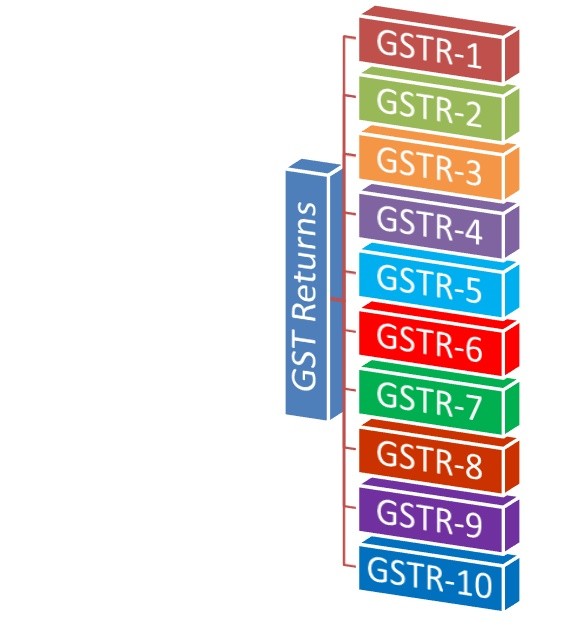India is rapidly moving towards its biggest Indirect Tax reform, the implementation of Goods & Services Tax (GST). In current economic environment, there is need for one Integrated Indirect tax to remove the adversities and problems viz.
- Cascading effect
- Increasing number of taxes, complexities, litigations
- Different tax rates across the country
- Tax evasion
- Problems in course of inter-state trade
- Plenty of compliances
- Corruption in State VAT departments
GST will encounter all these problems and make One India One Tax One Market and will also widen the tax base and minimize tax gap along with easy and robust monitoring mechanism.
Returns are essential and a vital part of any tax structure. It is an important tool to collect the financial data and other related information, so as to enable the Department to have a concrete database for enforcing the compliance part and helps in efficient and effective monitoring. Return is a powerful tool for tax administration department and government for:
- Ensuring Compliance
- Assessment of Tax liability of tax payer
- Inputs for Policy making
- Data for various economic indicators like GDP, PMI, IIP etc.

GSTR-1 - Outward Supply Return
A taxpayer will have to file GSTR-1 giving details of various types of supplies made in a month, i.e, outward supplies to registered taxpayers, unregistered dealers, exempted supplies,supplies not covered in GST, exports, credit/debit notes etc.
For each supply, taxable values will also be required to be provided along with transaction value.
GSTR-2 - Inward Supply Return
GSTR-2 will be return for inward supplies, w.r.t. various supplies received in a month. While most part of the GSTR-2 will be auto-populated, some details and transactions like imports, purchase from unregistered dealers, exempt or supplies not covered under GST. Tax payer will be required to check the auto-populated part of GSTR-2.
If any supply is not mentioned therein, tax payer can himself enter the invoice and transaction details for invoice not uploaded by supplier. Input Credit of the same will be given provisionally, subject to matching.
GSTR-3 Summary Return
Every registered tax payer will have to e-file the GSTR-3 form.
Part-A of the GSTR-3 will be auto generated from GSTR-1, GSTR-2 and Part-B sub Part (a) from electronic tax liability register of the taxpayer.
Taxable person will be required to discharge his/her tax liability as per GSTR-3 and fill the details accordingly in sub part (b) of Part-B of GSTR-3, OR may claim refund through the same.
GSTR-4 Return of Composition Dealer
Composition tax payers do not need to file any statement of outward or inward supplies. They have to file quarterly return in Form GSTR-4 by the 1st of the month after the end of the quarter. Since they are not eligible for any input tax credit, there is no relevance of GSTR-2 for them and as they can not pass on any credit, so GSTR-1 also becomes irrelevant. In their return, they have to declare summary details of their outward and inward supplies along with the details of tax payment.
GSTR-5 For Non-Resident Person
Non-resident person shall file return in GSTR 5 including therein details of outward and inward supplies and shall pay tax etc. within 21 days after the end of tax period or within 7 days after last day of validity of registration whichever is earlier.
GSTR-6 Input Service Distributor (ISD)
The Input Service Distributers (ISD) need to file only a return in GSTR-6 and the return has the details of credit received by them from the service provider and the credit distributed by them to the subsidiaries.
GSTR-7 Tax Deduction or TDS Return
Yes, you read that right TDS in GST. TDS in Indirect tax is not new concept as it is existing in VAT. TDS shall be deducted only by:
- Department or establishment of Central or State govt.
- Local Authority
- Government agencies
- Any other person as may be notified by CG or SG in this regard
So, only these persons will be required to file GSTR-7 by 10th of next month. Tax payer will need to confirm these details in GSTR-2.
GSTR-8 Return for Tax Collectors
GSTR-8 is to be filed by tax payer providing details of supply of goods and services affected through E-commerce operators, on which he was required to collect tax.
GSTR-9 Annual Return
All tax payers filing return in GSTR 1 to 3; other than composition dealers; will be required file an annual return in GSTR-9. Non-resident taxpayers, ISDs and person authorized to deduct TDS on GST are required to submit an annual return.
GSTR-10 Final or Last Return
Any tax payer who has closed business or has surrendered his registration or it has been cancelled by any reason, will be required file final return in GSTR-10.
|
Form No. |
Due Date |
|
GSTR-1 |
10th of the following month |
|
GSTR-2 |
15th of the following month |
|
GSTR-3 |
20th of the following month |
|
GSTR-4 |
18th of the first month next to quarter ending |
|
GSTR-5 |
Within 21 days after end of tax period or 7 days within last date of validity of registration, whichever is earlier |
|
GSTR-6 |
13th of month next to tax period |
|
GSTR-7 |
10th of month next to month of deduction |
|
GSTR-8 |
10th of month next to month of deduction |
|
GSTR-9 |
31st December of next Financial Year |
|
GSTR-10 |
Within 3 months of date of cancellation or surrender |
Tax payers can file their returns directly on the GST portal (www.gst.gov.in) online. Also, an offline utility will be available for preparing returns which can be downloaded from the portal.
DISCLAIMER: All the information provided above is based on Model GST Law and Draft GST Rules and thereby is subject to change.








 CAclubindia
CAclubindia

